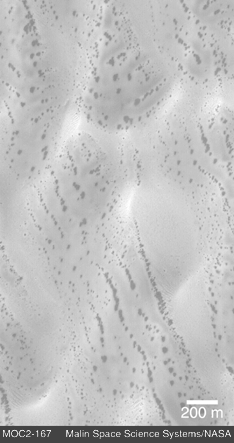
Mars Global Surveyor
Mars Orbiter Camera
Defrosting Polar Dunes--"The Snow Leopard"
MGS MOC Release No. MOC2-167, 10 August 1999

The patterns created by dark spots on defrosting south polar dunes
are often strange and beautiful. This picture, which the Mars Orbiter
Camera team has dubbed, "the snow leopard," shows a dune field
located at 61.5°S, 18.9°W, as it appeared on July 1, 1999.
The spots are areas where dark sand has been exposed from beneath
bright frost as the south polar winter cap begins to retreat. Many of the
spots have a diffuse, bright ring around them--this is thought to be
fresh frost that was re-precipitated after being removed from the dark
spot. The spots seen on defrosting polar dunes are a new phenomenon
that was not observed by previous spacecraft missions to Mars. Thus, there
is much about these features that remains unknown. For example, no one
yet knows why the dunes become defrosted by forming small spots that grow
and grow over time. No one knows for sure if the bright rings around the
dark spots are actually composed of re-precipitated frost. And no one
knows for sure why some dunes show spots that appear to be "lined-up"
(as they do in the picture above).
This Mars Global Surveyor Mars Orbiter Camera image is illuminated from
the upper left. North is toward the upper right. The scale bar indicates
a distance of 200 meters (656 feet).
Additional pictures and discussion of defrosting polar dunes are shown in:
Also, from 1998, see:
Malin Space Science Systems and the California Institute of Technology
built the MOC using spare hardware from the Mars Observer mission. MSSS
operates the camera from its facilities in San Diego, CA. The Jet Propulsion
Laboratory's Mars Surveyor Operations Project operates the Mars Global Surveyor
spacecraft with its industrial partner, Lockheed Martin Astronautics, from
facilities in Pasadena, CA and Denver, CO.
 To MSSS Home Page
To MSSS Home Page
Contact: info@msss.com

